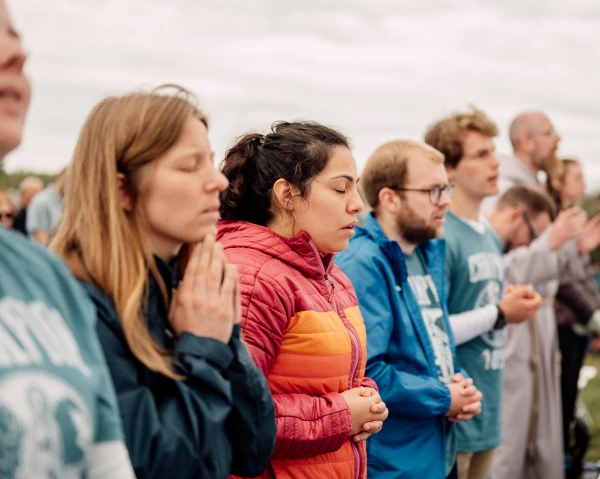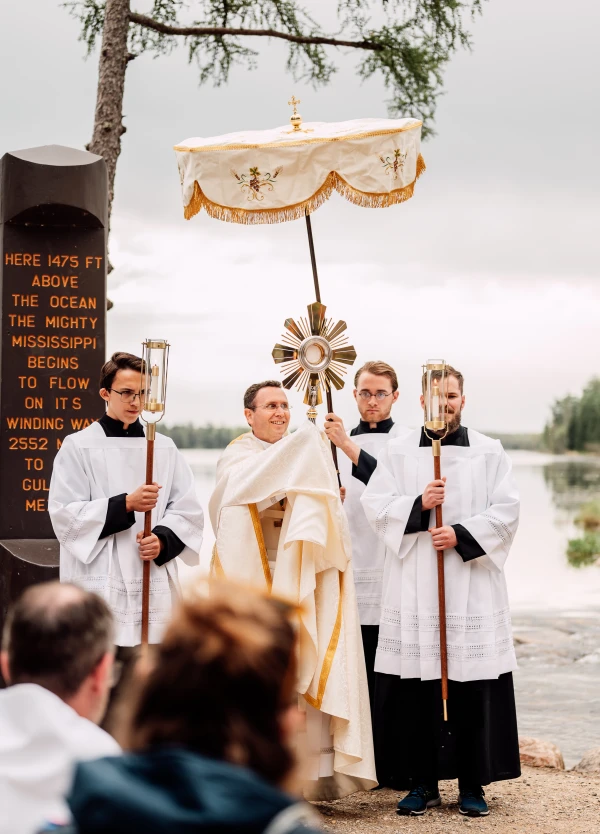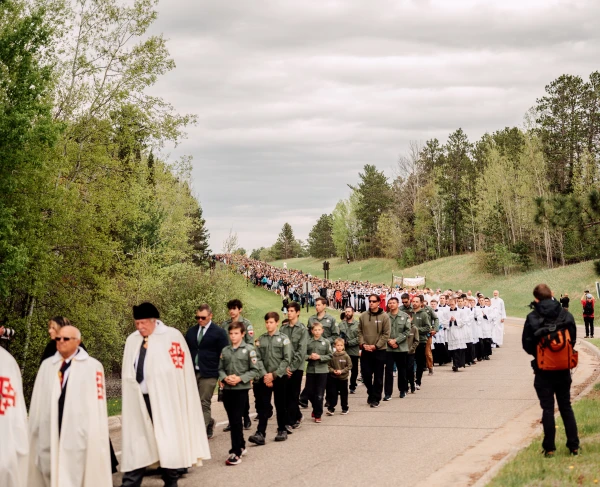Bemidji, Minnesota, May 19, 2024 / 21:47 pm
At the start of Mass Sunday at one of the launch sites of the National Eucharistic Pilgrimage, Bishop Andrew Cozzens remarked that although he had his hiking shoes on, the journey ahead would need something more than natural support to reach its intended destination.
“In order to make this pilgrimage fruitful, we need the Holy Spirit,” said the Diocese of Crookston, Minnesota, bishop.
If that’s the case, then the National Eucharistic Pilgrimage is off to a fantastic start.
The pilgrimage’s four routes, which will crisscross the country over the next two months, began May 19 with Pentecost Sunday liturgies, processions of the Blessed Sacrament, and fervent prayers for an outpouring of the Holy Spirit to renew Eucharistic devotion throughout the United States.
“It’s perfect that we’re launching this on Pentecost because Pentecost was a revival,” Cozzens said during his homily, emphasizing that a revival is the work of the Holy Spirit on the hearts of believers, which leads ordinary people to seek extraordinary holiness.
Four routes, one pilgrimage
Joined by brother bishops, clergy, and lay faithful from Minnesota and beyond — some 2,000 people in total — Cozzens presided over an outdoor Mass at Itasca State Park, the starting point of both the Mississippi River but also the northern Marian Route, which will lead to the National Eucharistic Congress in Indianapolis in July.
The Mass was followed by a mile-long Eucharistic procession and benediction. Then, along the shores of Lake Itasca, Cozzens blessed the small cadre of “perpetual pilgrims” who will travel the whole route, and they set off along a dirt path through the woods.
Jesus in the Eucharist, the source of the Catholic faith, crossing the Mississippi River at its source. #MarianRoute pic.twitter.com/mdoT4IbE42
— Jonathan Liedl (@JLLiedl) May 19, 2024
Meanwhile, Eucharistic pilgrimage routes were also underway in the country’s east, west, and south.
In New Haven, Connecticut, the faithful began the St. Elizabeth Ann Seton Route with a Pentecost Vigil Mass celebrated by Archbishop Christopher Coyne at St. Mary’s Church, where Blessed Michael McGivney founded the Knights of Columbus and is entombed today, before a Sunday morning procession and a Eucharistic pilgrimage boat ride through the Long Island Sound.
The St. Juan Diego Route kicked off in the Diocese of Brownsville, Texas, with Mass at the Immaculate Conception Cathedral, celebrated by Bishop Daniel Flores, before pilgrims braved 90-degree heat to join the Eucharistic Lord for the route’s opening procession.
And in San Francisco, following Mass at the Cathedral of St. Mary celebrated by Archbishop Salvatore Cordileone, the faithful processed with the Eucharist across the 1.7-mile-long Golden Gate Bridge to kick off the St. Junipero Serra Route.
The Marian, Seton, Juan Diego, and Serra Routes will eventually converge in Indianapolis for the 10th National Eucharistic Congress July 17–21.
And they’re off!
— Catherine Hadro (@CatHadro) May 19, 2024
The National Eucharistic Pilgrimage’s Eastern Seton Route has officially begun with a Solemn Pentecost Vigil Mass celebrated by Abp. Coyne in St. Mary’s Church - where Blessed Michael McGivney’s remains are entombed.
📍New Haven, CT pic.twitter.com/tTFJbG3uG9
Cozzens has served as the U.S. bishops’ leader of the wider National Eucharistic Revival, which began in 2022 and includes the pilgrimage and congress. At the Mass in Minnesota, he asked rhetorically what would happen if the bishops of the United States called for a Eucharistic revival, including two years of prayer before the Blessed Sacrament, and a cross-country pilgrimage that asked the Lord to pour out his Holy Spirit upon the whole country.
(Story continues below)
“What would happen if the bishops did that?” said Cozzens, who will join pilgrims in a 12-mile walk to Walker, Minnesota, in the Diocese of Duluth on Monday. “Well, we’re about to find out.”
Come Holy Spirit
Cozzens told those gathered that, just like the first Pentecost led to Christianity’s spread throughout the Roman Empire, the Holy Spirit could act through the National Eucharistic Revival to start a fire of divine love that would engulf the nation.
But if that was going to happen, it would require those gathered to embrace repentance, prayer, and the pursuit of holiness, so that the Lord can “enkindle in our hearts his fire so that we can be the saints he’s calling us to be.”
“Brothers and sisters, would you like to see a revival in our country? Then it has to begin with you and me.”

The thousands gathered in the grassy field for Mass included several families with young children who had brought lawn chairs from home in lieu of pews.
Instead of the Parthians, Medes, and Elamites mentioned in the Mass readings’ account of the original descent of the Holy Spirit, “out-of-towners” present for the Minnesota Pentecost liturgy included Iowans, Dakotans, and Wisconsinites, some of whom had made lengthy journeys to take part in the historic occasion.
Doug and Stephanie Carder and their four young children, ages 8 years to 4 months, came all the way from Clear Lake, Iowa, about six hours away by car. The family camped the night before in the state park and were drawn by the chance to gather outdoors with other Catholics on Pentecost, the feast of the birth of the Church, and give thanks.
“We wanted to give thanksgiving for Jesus’ presence in the Eucharist and to ask that others come to know him that way and love him that way through this pilgrimage,” Stephanie Carder said.
Sunoh and Jenna Choe came from the Twin Cities to take part in the Marian Route’s start, and both shared their hopes for how the Holy Spirit would work through the National Eucharistic Pilgrimage and the wider revival.
“I’m just really hopeful about the Eucharistic revival, and how this is going to change parishes and inspire people to evangelize,” Sunoh Choe said.

Mass intentions asked God to renew Eucharistic faith across the country, to bring those who had fallen away back to the Church, and to draw the nation to Jesus through the pilgrimage routes about to embark across the country. The eight perpetual pilgrims who will travel the entire Marian Route were also invited forward to receive a special blessing from Cozzens.
When Mass concluded, those gathered joined the Eucharist in a one-mile procession to the headwaters visitor center, crossing through dense pine forests and across a bridge over the Mississippi River in fledgling form.
At the front of the procession, between the Knights and Ladies of the Holy Sepulcher, were about 20 father and son members of the Troop of St. George, a Catholic scouting group. Tom Schulzetenberg of Blaine, Minnesota, said he had told the participating scouts that they were taking part in a “historic moment, that they’d probably never get to do again in their lifetime.”

“I wanted my two sons and all of these other fathers and sons to be a part of that, to show that public expressions of our faith are important,” Schulzetenberg said.
Father Paul Shovelain, pastor of St. John the Baptist in New Brighton, Minnesota, came with about 50 of his parishioners to participate in the Marian Route’s launch. He said he was excited to see how the pilgrimage could be a witness to many that “the Lord is staying with us” — including people like the park rangers and state park visitors, many of whom looked on the Eucharistic procession with curiosity, asking participants what was going on.
Jim Louden, a knight of the Holy Sepulcher and lawyer in the Twin Cities, said he was grateful for the opportunity for spiritual formation at the Marian Route’s start, including the two-day Star of the North Eucharistic Congress that had taken place in nearby Bemidji the day before, featuring talks from renowned catechists such as Bishop Robert Barron and Father Mike Schmitz. He said he hoped the event would “help light a spark in the world so that others can follow Christ.”
“We’re just hoping and praying that this can be the beginning.”












